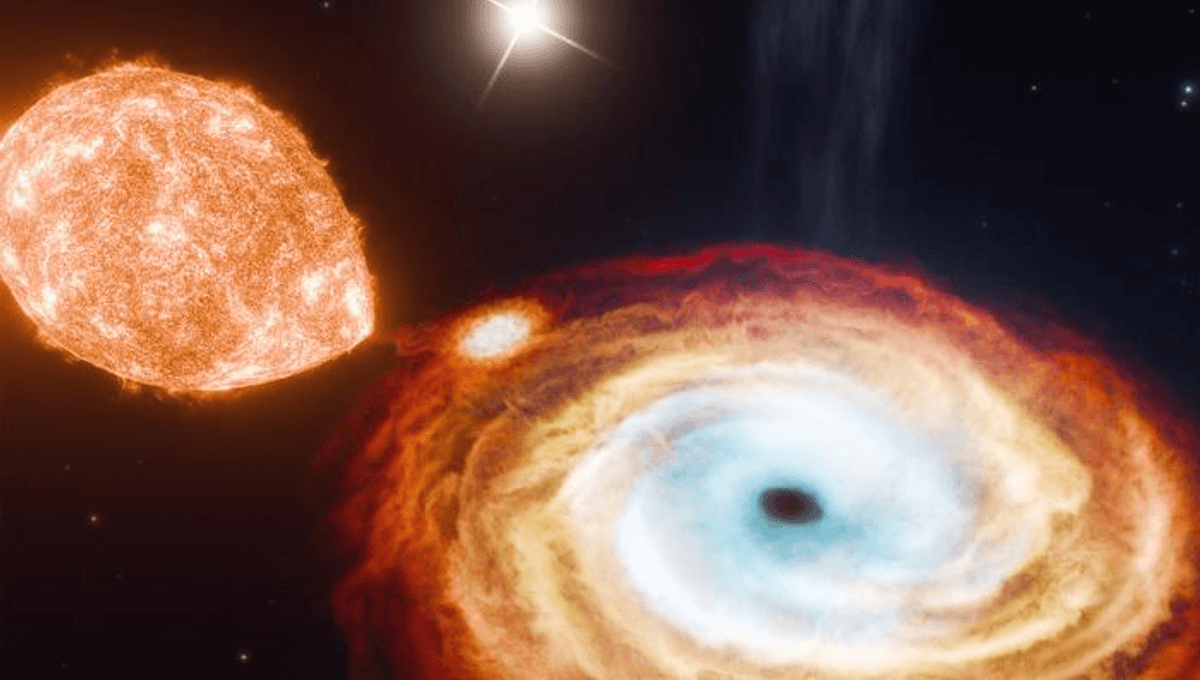
An X-ray binary system composed of a black hole and a star in the process of being consumed turns out to have a third member circling. Unless some unlikely scenarios occurred, the existence of what the discoverers are calling a “black hole triple” indicates a previously unseen method for making black holes.
Since we can’t see black holes directly, there could be a lot of them lurking in space without our knowledge. Putting that uncomfortable thought aside, when we do become aware of them, it’s usually from high-energy emissions as a companion star gets slowly consumed, creating what is known as an X-ray binary. V404 Cygni was one of the first of these to be discovered, and one of the most studied, but has now emerged as something more.
Triple star systems exist – we only have to look at our nearest neighbor – but they are a great deal rarer than binaries. Moreover, when neutron stars form from supernovae, they are known to blast out so much energy that nearby stars or planets can be thrown out of the system, something known as a “natal kick”. It is thought such natal kicks are the main cause of the runaway stars we sometimes find careering across the galaxy.
Since stellar mass black holes are the products of even larger stars, it’s logical to expect more powerful explosions, accompanied by greater natal kicks. Even if a black hole formed in a triple star system, went the argument, at least one component would be kicked out, leaving a binary.
However, astronomers have started to see hints this might not be the case, and now have something close to proof.
V404 Cygni was known to consist of a black hole with a mass nine times the Sun’s orbited by a star around every 6.5 days, close enough that gas is being drawn from the star’s outer layers and into the black hole’s gravity well. Now, MIT Professor Kevin Burdge and co-authors have found another companion orbiting every 70,000 years.
A close companion might be greatly affected by a supernova, but would be so tightly bound the natal kick might not get rid of it. However, the binding between stars with an orbital period of 70,000 years would be exceptionally weak.
“Imagine you’re pulling a kite, and instead of a strong string, you’re pulling with a spider web,” Burdge said in a statement. “If you tugged too hard, the web would break and you’d lose the kite. Gravity is like this barely bound string that’s really weak, and if you do anything dramatic to the inner binary, you’re going to lose the outer star.”
Burdge and co-authors calculate the natal kick when V404 Cygni was formed could not have been more than 5 kilometers a second (11,000 mph), much less than is considered normal for supernovae leading to neutron stars.
This has led Burge and coauthors to propose the V404 Cygni black hole was formed through “direct collapse”, without a supernova stage. Physicists have been toying with the idea of direct collapse for giant stars for years, but this is the first evidence, made stronger when measurement of V404 Cygni’s motions found it moving at the same rate as nearby stars.
“We think most black holes form from violent explosions of stars, but this discovery helps call that into question,” Burdge said. “This system is super exciting for black hole evolution, and it also raises questions of whether there are more triples out there.”
The possibility that black hole triples are somewhat common is increased by the fact the team found it without deliberately looking for it. They were searching for undiscovered black holes within the Milky Way using a database of telescope images. Burdge decided to see what a famous known example looked like with these instruments, and picked V404 Cygni.
Burdge wasn’t the first to notice an apparently close star, but others have assumed they just happened to line up, and the star was either much closer or more distant than the black hole. Burdge investigated instead and found that 10 years of Gaia data shows they are moving together.
The team concluded the additional star is a hundred times as far from the black hole as Pluto is from the Sun. The fact the outer companion would never have been noticed if the system was 50 percent further away, or it was more than 40 percent less massive, emphasizes how likely it is we are missing additional examples.
It is possible the third star was captured after the black hole formed, but the authors think this is unlikely given the low density of stars in the area. Likewise, they argue the window in which the outermost star was once closer – and got kicked to such a distance, but not out entirely – is so tiny as to be barely plausible.
The discovery comes with a scientific bonus: A star in the process of being consumed doesn’t follow the normal laws of aging, but one as far away as the third member does. Consequently, the outermost companion has been measured as 3-5 billion years old. If the three formed together, the black hole would have spent a tiny fraction of that time as an ordinary star, before its metamorphosis. “We’ve never been able to do this before for an old black hole,” Burdge said.
Perhaps the name could have been a clue: V404, supernova traces not found.
Supermassive black holes form through a different process, and can come together when galaxies merge. Consequently, many examples have been found with two orbiting each other, often while at least one is snacking on a star. We’ve even seen a triple black hole system. However, the frequency of these events doesn’t mean the same was expected for stellar mass black holes.
The study is published in the journal Nature.
Source Link: First “Black Hole Triple” Challenges Models Of How Giant Stars Die